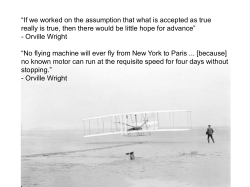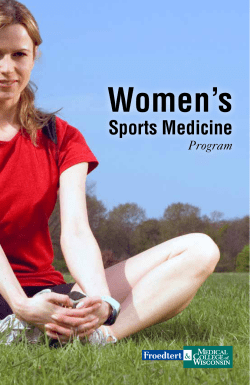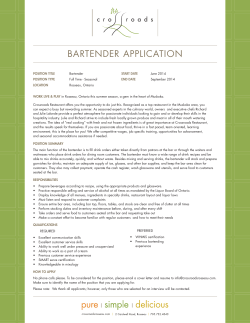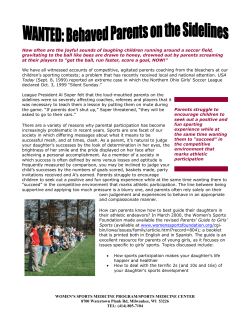
Functions of Water in the Human Body
Functions of Water in the Human Body The body is composed of 50-75% of water, depending on age and body fatness. Water is essential for living, significantly more so than food. Death will usually occur after one week without any liquids (2 to 3 days in the heat) but humans have been known to survive some months without food. The common rate of sweat loss is about 275ml in the heat. Prolonged exercise performance can be impaired by depletion of the body's energy stores and by disturbances of water and electrolyte balance. Exercise can exceed two liters per hour in highly fit and well-acclimatized athletes. Even more modest and common rates of sweat loss (e.g., 1 - 1.5 l/h) sustained for 30 to 60 minutes can result in dehydration that is of sufficient magnitude to negatively affect cardiovascular, thermoregulatory, and performance responses. There is, however, a limit to the body's ability to maintain physiological homeostasis during exercise in a warm environment when the body is no longer capable of coping with the demands placed upon it. The Relationship of Water and Exercise In Exercise Physiology, Water plays an important role in two aspects: "Heat Dissipation" and "Physiological Homeostasis". 1. Heat Dissipation Regulates body temperature through perspiration. 2. Physiological Homeostasis Water helps to maintain the physical equilibrium, to regulate its internal environment to maintain a stable, constant condition for adapting the physical activity. Normal body water turnover in an adult is from 1.7 to 2.3 L/day 1. Respiration: vigorous exercise can dissipate1-5ml water per minute 2. Sweat: about 500ml per day (depending upon temperature and humidity) 3. Urine excretion: about 1000-1500ml per day 4. Stool excretion: about 100-200mg per day Effects of Dehydration on Physiology and Performance Inadequate drinking during strenuous activity can result in dehydration and impaired athletic performance. During intense physical activity, athletes often do not drink enough fluids to replace what they lose in exercise, resulting in what's called "voluntary dehydration". The followings are the physiological consequences between difference dehydration levels: - Fluid losses of as little as 1% of body weight (about 600ml), cause heart rate to be elevated, cardiac output to be declined, and core temperature to be raised. - Fluid losses of 2% of body weight (less than 4 pounds in a 200-pound athlete), due to the dysfunction of homeostatic, it can impair performance by raising the body temperature and increasing fatigue who fails to replace body fluids. - Fluid losses of 4-6% of body weight (about 2400-3600ml) will decrease muscle strength and muscle endurance. And heat spasm often develops. The performance ability may lower by 20-30% and also affected the anaerobic capacity. Besides, there are progressive increases in the concentrations of sodium and other dissolved substances in the blood plasma, a lower blood flow to the skin, and a higher core temperature which will increase the chance of heat stroke. - Fluid losses over 6% of body weight (> 3600ml). Dehydration compromises symptoms of impaired cardiovascular function often develop (e.g., syncope, heat exhaustion, heat spasm), and, in severe cases, neurological failure and severe hyperthermia ensue (e.g., heat stroke). Suggestions for Fluid Intake - Voluntary drinking before the thirst signals. Initially, one experiences thirst and discomfort when they lose 1% of body fluid. If you feel thirsty, you are already dehydrated. - Try to avoid caffeinated and alcoholic beverages, while they do supply water to the body initially, contain diuretics that cause the body to lose water. - Cold beverages are more palatable during and after exercise, and this greater palatability will increase fluid consumption by athletes. Drinking cold beverages (8-12°C) causes a slight transient cooling of the upper digestive tract. - Sports drink consists with minerals, Sports drinks are intended to replenish electrolytes, sugar, water, and other nutrients, and are usually isotonic (containing the same proportions as found in the human body). Non-athletes who use sports drinks should also be aware that sports drinks for athletes typically contain high levels of carbohydrates which will result in weight gain if consumed without a corresponding increase in exercise activity. - Try to avoid concentrated juice, sweetened drinks, chocolate milk and soda. These sugared beverages will lower the rehydration rate. - The choice of drink will depend on whether you need a drink to replace fluid losses or to provide more energy / carbohydrate or both. Either plain water or sports drink which contain 4 to 8% carbohydrate are suitable. Fluid intake before exercise Prehydrating - Drink approximately 600ml of fluids up to two hours before an endurance exercise session. - Drink 200ml of fluids 15 minutes before exercise. Fluid intake during exercise - During intense and prolonged exercise sessions, or exercising in a hot/humid environment, drink 150-350ml. every 15 to 20 minutes. (depending on individual sweating rate, exercise duration) - Splash some water onto the skin surface can help to reduce the sweat evaporation during exercise. - Plain water is useful in non-endurance events of low intensity, where carbohydrate replacement is not the priority. Since it is much faster to be absorbed into the body. - If exercise duration is longer than one hour, consuming sports drinks can sustain fluid-electrolyte balance and exercise performance. Ingestion of approximately 30-60 g of carbohydrate during each hour of exercise will generally be sufficient to maintain high rates of oxidation of blood glucose late in exercise and to delay fatigue. Fluid intake after exercise - After exercise drink enough fluids to replace quench your thirst plus extra. - Use body weight after exercise as a guideline. Drink 480ml of fluids for every pounds lose. Avoid excessive fluid consumption after exercise - Over-drinking (1-2L)will increase the blood circulation, so as to increase the workload for the cardiovascular system. - The potential danger of excessive fluid consumption which may, in the extreme, result in a low blood sodium concentration or hyponatremia, while the sodium concentration in the plasma falls below 135 mmol/L. Hyponatremia is a rare occurrence, it is a dangerous condition that may arise when athletes drink too much water, diluting the body's sodium. Reference American College of Sports Medicine, ACSM (2007), Exercise and Fluid Replacement. Dietitians in Sports & Exercise Nutrition. Fluids and Hydration in Sport Fluids and Hydration in Sport, Retrieved April 16, 2007, from http://www.disen.org/nutrition/pages-to-edit/fluids.htm Edward E Coyle, Ph.D. (1994).? Fluid and carbohydrate replacement during exercise: How much and why? Sport Science Library#50, Volume 7, Number 3, Department of Kinesiology and Health Education, The University of Texas at Austin Institute of Medicine (2004). Dietary Reference Intakes for water, potassium, sodium, chloride, and sulfate. Washington, DC: The National Academies Press, in press. www.iom.edu/report.asp?id=18495 Gatorade Sports Science Institute, Retrieved April 13, 2007, from http://www.gssiweb.com Murray R et al. (2003), Hyponatremia in athletes. Sports Science Exchange. 2003; 16(1)1-6. Sawka, M. and K. Pandolf. Effects of body water loss on physiological function and exercise performance, in Perspectives in Exercise Science and Sports Medicine, Volume 3: Fluid Homeostasis During Exercise. Indianapolis: Benchmark Press, 1990. Watson water. Seminar on Watsons Water Distance Running Traininf and Strategies, Retrieved April 13, 2007, from http://www.watsons-water.com/images/handout_2301.pdf. 總編譯: 王香生, 翻譯:王香生、胡美怡(2000), 香港中文大學體育運動科學系, 營養與運動表現, Retrieved April 13, 2007, from http://www.acsm.org/AM/Template.cfm?Section=Search&Template=/CM/ContentDisplay.cfm&ContentID=3587 運動與飲水>, Retrieved April 13, 2007, from http://www.lstlcw.edu.hk/peweb/water.htm < 沈劍威 阮伯仁(2006),《康盛人生系列:體適能基礎理論》香港體適能總會
© Copyright 2025





















